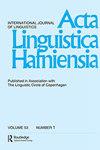和谐的语义和语用解释
Q2 Arts and Humanities
引用次数: 0
摘要
摘要本文介绍了一种面向语义和语用的类型概括,即定位原则。连接词的位置被定义为一个单一的词汇范畴,包括副词和连词,这为跨语言数据中的一些和谐关联提供了解释原则。在这种见解的指导下,对数据进行重新分析,作为处理方法的替代方法。本文章由计算机程序翻译,如有差异,请以英文原文为准。
A semantic and pragmatic explanation of harmony
ABSTRACT This paper introduces a semantically and pragmatically oriented typological generalisation, which is named the orientation principle. It entails that the position of connectives, as defined as a single lexical category including adpositions and conjunctions, provides an explanatory principle for a number of harmonic correlations in crosslinguistic data. A reanalysis of the data guided by this insight is proposed as an alternative to processing approaches.
求助全文
通过发布文献求助,成功后即可免费获取论文全文。
去求助
来源期刊

Acta Linguistica Hafniensia
Arts and Humanities-Language and Linguistics
CiteScore
0.90
自引率
0.00%
发文量
5
 求助内容:
求助内容: 应助结果提醒方式:
应助结果提醒方式:


